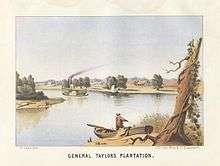Cypress Grove Plantation
.jpg)
The Cypress Grove Plantation was a Southern plantation owned by President Zachary Taylor in Rodney, Mississippi. Later, it was also known as Buena Vista Plantation.[1]
Location
The plantation bordered Ashland Plantation and the Mississippi River.[1] It was near the Ashland community, and Ashland's port was sometimes used by Cypress Grove Plantation.[2] The plantation was also located on the Mississippi River ten miles below Rodney,[1] a small town on the Mississippi River in Jefferson County, Mississippi.[3][4] It was north of Natchez.[5]
History

The plantation was purchased by General Zachary Taylor in 1840.[3] The land spanned 1,923 acres.[3][5] It was purchased from David Hunt and others by John Hagan of New Orleans, and then sold to Taylor for $95,000.[1] It came with eighty-one African "servants," as Taylor called them, and with horses, mules, cattle and equipment.[3][1] Taylor and his wife, Margaret Taylor, often visited the plantation until he was elected President of the United States in 1848.[3] Indeed, she spent most of her time at the plantation while he was serving in the Mexican-American War.[3][5] Though Taylor won many battles in the war, the Battle of Buena Vista was his last victory in 1847.[1] The plantation became known as Buena Vista when Taylor returned from the war.[1]
Taylor's parents - Colonel Richard and Sara Strother Taylor - raised him on their plantation, so he had experience running a plantation.[1] Cotton, tobacco, corn and wheat were grown, and hogs, sheep, cattle and poultry were raised on his plantation.[3] He grew potatoes and peas in his garden.[3] His home on the plantation was made of timber and included a large library.[3][5] He also had a sawmill on this plantation.[3]
Taylor first hired a cousin of his wife, Damascus Thornton, as the first overseer.[6] He later hired another cousin, James Thornton, until the latter resigned in 1845.[5] The third overseer was Thomas W. Ringgold.[3] Taylor corresponded with Ringgold from Corpus Christi, Texas and Mexico during the Mexican-American War.[7] According to biographer K. Jack Bauer, his slaves were treated well, well-fed and even received Christmas presents each year.[3][5] On top of picking cotton and other crops, they built levees on the Mississippi River and on an adjacent creek.[3] Later, Taylor's son, General Richard Taylor, helped manage the plantation.[3]
Mississippi River travelers could cut ten miles from their trip by going through Gillam's Shute which flowed between Buena Vista Island and Taylor's plantation.[1] Thus, the plantation was well known to river travelers.[1] Taylor died on July 9, 1850.[1] Taylor's widow, Margaret, and the other heirs sold the plantation land in 1850 to Charles B. New for $20,000.[1] Most of the land has since eroded away into the Mississippi River.[1]
References
- 1 2 3 4 5 6 7 8 9 10 11 12 13 Logan, Marie T. (1980). Mississippi-Louisiana Border Country: Revised Edition (Revised (2nd) ed.). Baton Rouge, Louisiana: Claitor's Publishing Division. pp. 69–72.
- ↑ Bragg, Marion (1977). Historic Names and Places on the Lower Mississippi River (PDF). Mississippi River Commission. p. 181.
- 1 2 3 4 5 6 7 8 9 10 11 12 13 14 Stanley Nelson, Taylor's Cypress Grove Plantation, The Ouachita Citizen, August 6, 2014
- ↑ June Davis Davidson, Country Stores of Mississippi, Charleston, South Carolina: The History Press, 2014, p. 94
- 1 2 3 4 5 6 K. Jack Bauer, Zachary Taylor: Soldier, Planter, Statesman of the Old Southwest, Baton Rouge, Louisiana: Louisiana State University, 1993, p. 107-108
- ↑ Holman Hamilton, The Three Kentucky Presidents: Lincoln, Taylor, Davis, Louisville, Kentucky: University Press of Kentucky, 2003, p. 23
- ↑ Stephen Currie, Zachary Taylor, Plantation Owner, Civil War History, Volume 30, Number 2, June 1984, pp. 144-156